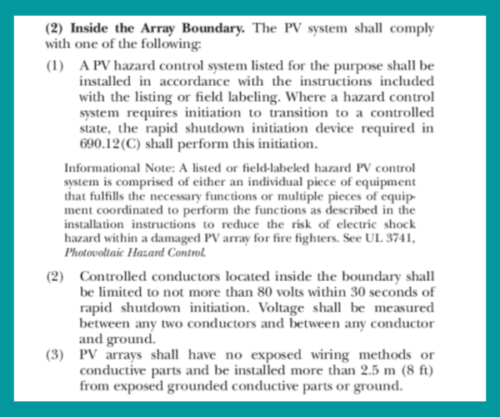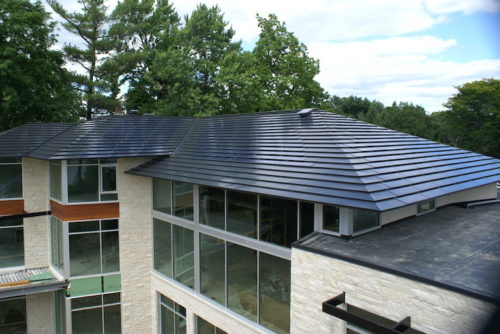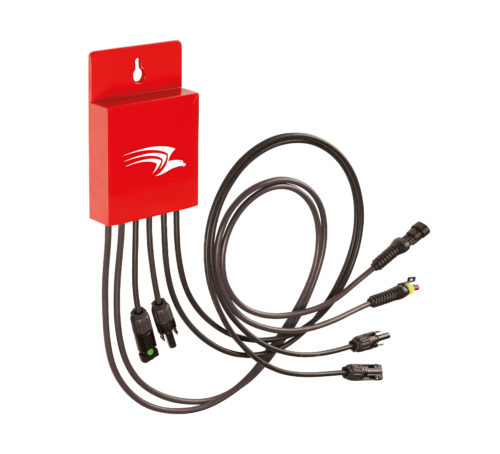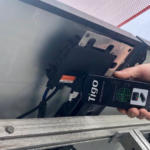The module-level PV rapid shutdown compliance option in the 2017 National Electrical Code was a major shift from previous string-level rapid shutdown requirements. But module-level shutdown is just one of three ways a solar project can comply with current rapid shutdown requirements in the widely adopted 2017 code. A new 2020 code is beginning to be adopted by some states, but the rapid shutdown compliance options remain largely the same — get the voltage both outside and inside the solar array down quickly.
The three choices for compliance should be welcome news for building-integrated PV manufacturers, some of which have been wondering how to cost-effectively perform module-level shutdown of smaller solar shingles or tiles.
“The code offers those three options as ways to say there’s different installation practices that can be used depending upon the particular rooftop PV installation,” said Ken Boyce, senior director of principal engineering for industrial at UL.
First: An important note. There are two separate requirements in NEC section 690.12 for rapid shutdown. One is for outside the array, where the conductors enter the building, and two is for inside the array boundary. Outside the array boundary, conductors are limited to 30 V within 30 seconds of rapid shutdown initiation. Some rapid shutdown approaches can satisfy both requirements by bringing the voltage both outside and inside the array down to less than 30 V in 30 seconds, Boyce said.
 This second category — inside the array boundary and its three rapid shutdown options — is the main focus of this article.
This second category — inside the array boundary and its three rapid shutdown options — is the main focus of this article.
Under the “inside the array boundary” code requirements, there are two compliance options that are somewhat tailored to BIPV solutions like Tesla’s Solar Roof tiles or Luma’s Solar Roof shingles.
The first and probably simplest way for a BIPV system to comply with the code has to do with the materials used in the product. NEC 690.12(B)(2)(3) says projects can satisfy rapid shutdown for controlled conductors inside the array boundary if there are no exposed wires or conductive parts in the array. CertainTeed says it can use this compliance option with its Apollo II line of BIPV shingles, which has no exposed conductive parts.
“The flashing is all polymeric as is the Apollo frame, so we have no exposed metal,” said Mark Stancroff, CertainTeed solar director.
But this compliance option would not apply to products like Luma Solar’s shingles, which are made of conductive sheet metal.
For those metal BIPV offerings, 690.12(B)(2)(1) would likely be the simplest compliance option. This option is for projects to be listed or field-labeled as a PV rapid shutdown array — meaning the entire system, from modules to inverter, has been tested as a unit and proven to perform rapid shutdown. UL has created certifications for rapid shutdown PV arrays to prove just that. The newly published requirements in standard UL 3741 outline additional compliance options for accomplishing this.
For vertical-market manufacturers like Tesla that make every component in a system from the Solar Roof tiles to the inverter, system-level certification might be simple. But a full PV array rapid shutdown listing might not make sense for all manufacturers, since the solar industry is constantly churning out new versions of products. Acquiring system certification for every single combination could be cumbersome.
Still, if BIPV manufacturers want a somewhat simple way to breeze through rapid shutdown approval by AHJs, they could choose a limited combination of different components to use in projects and have them tested and listed as “PV rapid shutdown arrays.”
“I think [UL 3741] may be something that ultimately will help with design options,” Boyce said. “There’s an assurance, there’s a set of safety requirements that apply to those products that then can give the electrical inspector confidence that the products are being evaluated, and they’re focused then on making sure they enforce those code requirements rather than trying to figure out what’s going on inside the product.
“[UL 3741 is] so comprehensive in the way it’s been done at the certification level, it makes it much easier for an authority having jurisdiction to say yes,” Boyce continued.
Projects that won’t fit under those two easiest shutdown options for BIPV for whatever reason can still opt for module-level shutdown of BIPV modules, even though “it certainly seems like it would not be the easiest way to comply,” Boyce said. Module-level shutdown is implied in the third compliance option 690.12(B)(2)(2), which requires controlled conductors within the array boundary to limit power to 80 V within 30 seconds of rapid shutdown initiation.
The module-level requirement is straightforward when the modules in discussion are standard 65- by 39-in. solar panels. Clip or stick a rapid shutdown device on the back of each standard panel, connect the wiring and it’s compliant.
But achieving module-level compliance with BIPV offerings, which are much smaller products, isn’t as straightforward.
BIPV modules are almost always paired with string inverters rather than microinverters. Along with the sheer number of shingles or tiles per roof (around 125 shingles for a 10-kW Luma Solar roof), any device that’s tucked underneath must be able to withstand high temperatures.
“It’s like a solar thermal oven underneath the solar shingle. That’s the dilemma when you’re looking at a module-level rapid shutdown device or a rapid shutdown device that would be under 80 V within 30 seconds inside the array,” said Jeff Spies, president of solar design firm Planet Plan Sets.
Some technologies could potentially work for that tough environment, like IMO Automation’s FireRaptor rapid shutdown device, according to Spies. The FireRaptor is a solid-state switching device with no mechanical parts, making it better equipped to handle high heat conditions. IMO Automation’s general manager Joe Covington said the product could be sufficient for these applications depending on the system configuration, since it can handle up to a sustained ambient temperature of 188℉ before it initiates an automatic shutdown through its onboard temperature sensor.
Luma Solar has been looking at using module-level rapid shutdown for its solar shingle systems using APsystems’ or Generac’s rapid shutdown devices. Robert Allen, president of Luma Solar, isn’t concerned with much additional work on the jobsite since these devices are basically plug-and-play, but he acknowledges it will add an extra expense to the bill of materials.
“It’s just going to add costs, not only to our system, but others too,” Allen said. “But not anything that we can’t bear, because our product is a luxury product to begin with, so we don’t sell it on per-watt price points.”
At this time, AHJs across the country are still working on adopting and learning the 2017 code, so manufacturers likely have some time to determine the compliance options that work best for their products. Still, if BIPV options are to grow out of a niche market, manufacturers will need to find easy ways to get their systems up to code to ensure quick inspections and commissions.
Updated with clarification from IMO Automation on Feb. 9










Tell Us What You Think!